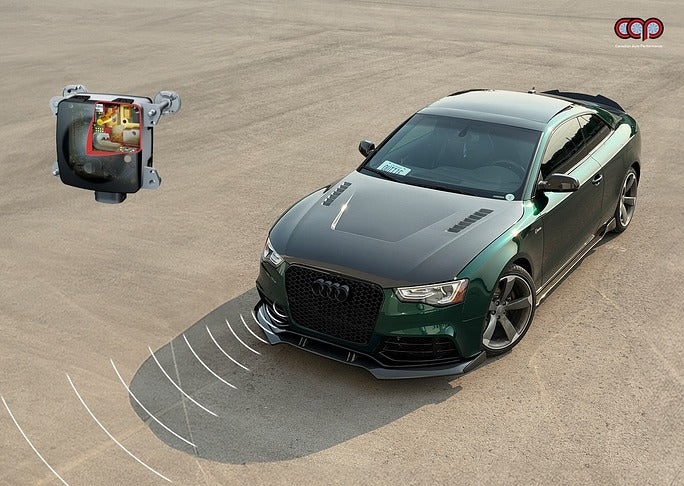
Account
Country
AUDI A8/S8/RS8
AUDI R8
Audi Q8/SQ8


German cars have always been synonymous with cutting-edge technology, and the Audi Adaptive Cruise Control (ACC) system is no exception. ACC is more than just a fancy feature - it's a sophisticated driver-assistance feature that is changing how people experience driving by enhancing acceleration levels. In this blog, we will explore everything you need to know about Audi ACC, from its core functions and benefits to its potential to revolutionize the future of driving.

Picture yourself on a highway, and the traffic slows down. Instead of the usual rush to hit the brakes, your Audi takes over, adjusting your speed to keep a safe distance from the car in front of your vehicle. That's the convenience of ACC in action, making your journey more relaxed and enjoyable.
Using a network of radar sensors and cameras, ACC acts as your co-pilot, monitoring the road ahead and responding to changing traffic conditions. Whether stuck in rush hour or enjoying a scenic road trip, ACC takes the pressure off, letting you focus on the road ahead with reduced stress.
As long ago as 2005, Audi, in tandem with Stanford University, won the DARPA Grand Challenge for automated vehicles. AAC is a popular feature, allowing drivers to maintain speed up to safe mph. And the best news is that Audi has made it available across their models since then.
Here's a quick look at some of the Audi vehicles that offer ACC and current model specifications:
|
Model |
Years of Production |
ACC Variations/Packages |
|
A4 |
2017-Present |
Adaptive Cruise Assist, Traffic Jam Assist |
|
A5 |
2017-Present |
Adaptive Cruise Assist, Traffic Jam Assist |
|
A6 |
2019-Present |
Adaptive Cruise Assist with Traffic Jam Assist and Turn Assist |
|
A7 |
2019-Present |
Adaptive Cruise Assist with Traffic Jam Assist and Turn Assist |
|
A8 |
2018-Present |
Adaptive Cruise Assist with Traffic Jam Assist and Intersection Assist |
|
Q3 |
2020-Present |
Adaptive Cruise Assist |
|
Q5 |
2018-Present |
Adaptive Cruise Assist, active lane assist, Traffic Jam Assist |
|
Q7 |
2017-Present |
Adaptive Cruise Assist, Traffic Jam Assist |
|
Q8 |
2019-Present |
Adaptive Cruise Assist with Traffic Jam Assist and Turn Assist |
|
e-tron |
2019-Present |
Adaptive Cruise Assist with Traffic Jam Assist and Turn Assist |
Important Note:
The specific ACC features and packages can vary based on the model year, trim level, and optional extras. To get the most accurate information, it's always best to check your vehicle's owner's manual or talk to an Audi dealer.
If you're unsure whether your Audi has ACC, there are many easy ways to find out. Start by checking your owner's manual – it should list all your car's features, including the driver information display. You can also look for the ACC controls, usually on the steering wheel or the center console. These controls typically include buttons for setting your speed following distance and turning the system on and off.

One of the great things about Audi ACC is that it's highly customizable. You can adjust the following distance to suit your comfort level, choosing from options like "Close," "Medium," and "Far." You can also set your desired cruising speed, and ACC will intelligently maintain it while adapting to the traffic flow and modifying the driving style for a more comfortable experience.
Audi's ACC goes beyond essential cruise control with some pretty impressive advanced features:
Traffic Jam Assist: Say goodbye to the stress of stop-and-go traffic. This feature can bring your Audi to a complete stop in traffic jams and automatically resume driving when the traffic starts moving again.
Predictive Efficiency Assist: This feature uses navigation data and speed limit information to optimize your ACC settings for better fuel economy.
Turn Assist: This safety feature helps prevent collisions when turning at low speeds by detecting oncoming traffic and applying the brakes if needed.
For manual transmission vehicles, ACC is less common because it requires frequent driver intervention to shift gears. While some manufacturers have integrated limited ACC features for manual transmissions, these systems often lack the seamless functionality of their automatic counterparts.
In contrast, If you're considering ACC, an automatic transmission is the key to unlocking its full potential. The seamless gear shifting provided by automatic systems allows ACC to maintain optimal speed and distance without driver interference. Audi’s implementation of ACC in automatic vehicles ensures a smooth and responsive driving experience, particularly in stop-and-go traffic and highway cruising.
ACC isn't just a cool tech gadget; it offers some real-world benefits that can significantly improve your driving experience:
Here are a few tips to help you get the most out of your Audi ACC:
Get to Know Your System: Before you hit the road, familiarize yourself with the ACC controls and settings in your specific Audi model.
Understand the Limitations: While ACC is a fantastic tool, it's important to remember that it has limitations. It might not work perfectly in bad weather or be able to react to sudden lane changes or pedestrians.
Stay Engaged: Even with the ACC activated, it is crucial to stay alert and ready to take control of the vehicle whenever necessary.
ACC proves its worth in a variety of driving situations:

On long journeys, ACC lets you maintain a steady speed and a safe following distance without constantly adjusting the accelerator. This reduces fatigue and makes the journey more comfortable.

ACC can be beneficial on winding mountain roads, where maintaining a safe speed and following distance can be challenging. The system can automatically adjust your speed to navigate curves and hills, improving safety and control.

In stop-and-go city traffic, ACC can relieve some of the stress of driving. At low speeds, ACC shines with its Traffic Jam Assist feature. Imagine crawling through bumper-to-bumper traffic without constantly pressing the accelerator or brakes. ACC takes control, maintaining a safe following distance and smoothly adjusting your speed as traffic fluctuates.
Whether it’s managing congestion during rush hour or inching forward in a packed parking lot, ACC reduces driver fatigue while enhancing safety. Combined with Turn Assist, it’s an invaluable tool for city dwellers and commuters alike.
Extreme weather presents unique challenges for Adaptive Cruise Control systems. Rain, snow, and fog can obstruct radar sensors and cameras, potentially affecting ACC’s ability to monitor the road ahead. However, Audi’s ACC system incorporates advanced sensor technology designed to mitigate these issues. For example, heated sensors help reduce fogging and ice buildup, ensuring functionality in cold conditions. Always use ACC as a supplementary tool and be prepared to take control if visibility or traction is compromised.
ACC isn't just about technology; it's about enhancing the human driving experience. By taking over some of the more mundane driving tasks, ACC reduces driver fatigue and boosts confidence by providing a sense of security. This is especially beneficial on long trips or in stressful traffic conditions.
In an age of growing environmental awareness, ACC offers a significant benefit: improved fuel efficiency. By maintaining a consistent speed and anticipating traffic flow, ACC can help optimize fuel consumption, which translates to fewer emissions and lower fuel costs. Studies have shown that ACC can improve fuel efficiency by up to 10%, making it a more sustainable driving choice.
Audi is constantly innovating and pushing the boundaries of driver-assistance technology. We can expect future versions of ACC to be even more sophisticated, with features like:
Increased Autonomy: Future ACC systems may offer higher levels of self-driving capability, potentially allowing for hands-free driving in certain situations.
Enhanced Predictive Capabilities: ACC may anticipate traffic flow and road conditions even further in advance, leading to smoother driving and better fuel efficiency.
Smart City Integration: Imagine ACC communicating with traffic lights and other vehicles to improve safety and traffic flow. That's the kind of innovation Audi is exploring.
ACC is beneficial in heavy traffic. It can automatically adjust your speed to maintain a safe following distance, even when traffic comes to a complete stop, making stop-and-go driving much less stressful.
ACC is the basic system that keeps a set distance from the car before you. Adaptive cruise assist adds extra features like lane-keeping and traffic jam assist, providing a more comprehensive driver assistance package.
When used correctly, Audi ACC is a safe and reliable system. It's designed to assist you, not replace your driving skills. So, while you can trust ACC to help you on the road, always remember to stay alert and ready to take control of the vehicle when needed.
To check if your Audi has Adaptive Cruise Control (ACC):
Look for the ACC controls on the steering wheel or center console, typically including buttons to adjust speed and following distance.
Consult your owner’s manual, which lists all the features installed in your vehicle.
Access the driver information display on your dashboard to look for ACC indicators.
Contact your local Audi dealership with your Vehicle Identification Number (VIN) to confirm installed features, or run it through a VIN checker
Activating ACC in your Audi is straightforward:
Always ensure that you remain alert and ready to take control as ACC is a driver-assistance system, not a substitute for active driving
Audi first introduced Adaptive Cruise Control (ACC) in 2005 as an optional feature on select models like the Audi A8 and A6. Over the years, ACC has been expanded across Audi’s lineup, with enhancements such as Traffic Jam Assist and Predictive Efficiency Assist added in newer models from 2017 onward.
No, cruise control, including Adaptive Cruise Control, is not harmful to your car’s engine or transmission when used appropriately. In fact, it can:
Improve fuel efficiency: By maintaining a consistent speed, reducing unnecessary acceleration and braking.
Reduce wear and tear: By avoiding frequent manual throttle inputs.
However, avoid using cruise control on steep inclines or declines, as it may strain the engine or transmission in certain situations. Always follow your vehicle’s operating guidelines for best results.